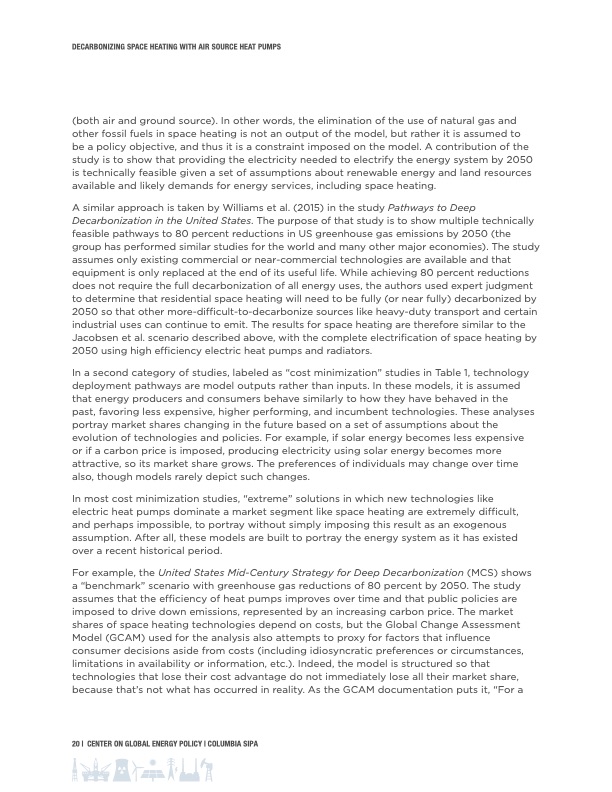
PDF Publication Title:
Text from PDF Page: 021
DECARBONIZING SPACE HEATING WITH AIR SOURCE HEAT PUMPS (both air and ground source). In other words, the elimination of the use of natural gas and other fossil fuels in space heating is not an output of the model, but rather it is assumed to be a policy objective, and thus it is a constraint imposed on the model. A contribution of the study is to show that providing the electricity needed to electrify the energy system by 2050 is technically feasible given a set of assumptions about renewable energy and land resources available and likely demands for energy services, including space heating. A similar approach is taken by Williams et al. (2015) in the study Pathways to Deep Decarbonization in the United States. The purpose of that study is to show multiple technically feasible pathways to 80 percent reductions in US greenhouse gas emissions by 2050 (the group has performed similar studies for the world and many other major economies). The study assumes only existing commercial or near-commercial technologies are available and that equipment is only replaced at the end of its useful life. While achieving 80 percent reductions does not require the full decarbonization of all energy uses, the authors used expert judgment to determine that residential space heating will need to be fully (or near fully) decarbonized by 2050 so that other more-difficult-to-decarbonize sources like heavy-duty transport and certain industrial uses can continue to emit. The results for space heating are therefore similar to the Jacobsen et al. scenario described above, with the complete electrification of space heating by 2050 using high efficiency electric heat pumps and radiators. In a second category of studies, labeled as “cost minimization” studies in Table 1, technology deployment pathways are model outputs rather than inputs. In these models, it is assumed that energy producers and consumers behave similarly to how they have behaved in the past, favoring less expensive, higher performing, and incumbent technologies. These analyses portray market shares changing in the future based on a set of assumptions about the evolution of technologies and policies. For example, if solar energy becomes less expensive or if a carbon price is imposed, producing electricity using solar energy becomes more attractive, so its market share grows. The preferences of individuals may change over time also, though models rarely depict such changes. In most cost minimization studies, “extreme” solutions in which new technologies like electric heat pumps dominate a market segment like space heating are extremely difficult, and perhaps impossible, to portray without simply imposing this result as an exogenous assumption. After all, these models are built to portray the energy system as it has existed over a recent historical period. For example, the United States Mid-Century Strategy for Deep Decarbonization (MCS) shows a “benchmark” scenario with greenhouse gas reductions of 80 percent by 2050. The study assumes that the efficiency of heat pumps improves over time and that public policies are imposed to drive down emissions, represented by an increasing carbon price. The market shares of space heating technologies depend on costs, but the Global Change Assessment Model (GCAM) used for the analysis also attempts to proxy for factors that influence consumer decisions aside from costs (including idiosyncratic preferences or circumstances, limitations in availability or information, etc.). Indeed, the model is structured so that technologies that lose their cost advantage do not immediately lose all their market share, because that’s not what has occurred in reality. As the GCAM documentation puts it, “For a 20 | CENTER ON GLOBAL ENERGY POLICY | COLUMBIA SIPAPDF Image | DECARBONIZING SPACE HEATING WITH HEAT PUMPS

PDF Search Title:
DECARBONIZING SPACE HEATING WITH HEAT PUMPSOriginal File Name Searched:
HeatPump-CGEP_Report_010220.pdfDIY PDF Search: Google It | Yahoo | Bing
CO2 Organic Rankine Cycle Experimenter Platform The supercritical CO2 phase change system is both a heat pump and organic rankine cycle which can be used for those purposes and as a supercritical extractor for advanced subcritical and supercritical extraction technology. Uses include producing nanoparticles, precious metal CO2 extraction, lithium battery recycling, and other applications... More Info
Heat Pumps CO2 ORC Heat Pump System Platform More Info
| CONTACT TEL: 608-238-6001 Email: greg@infinityturbine.com | RSS | AMP |